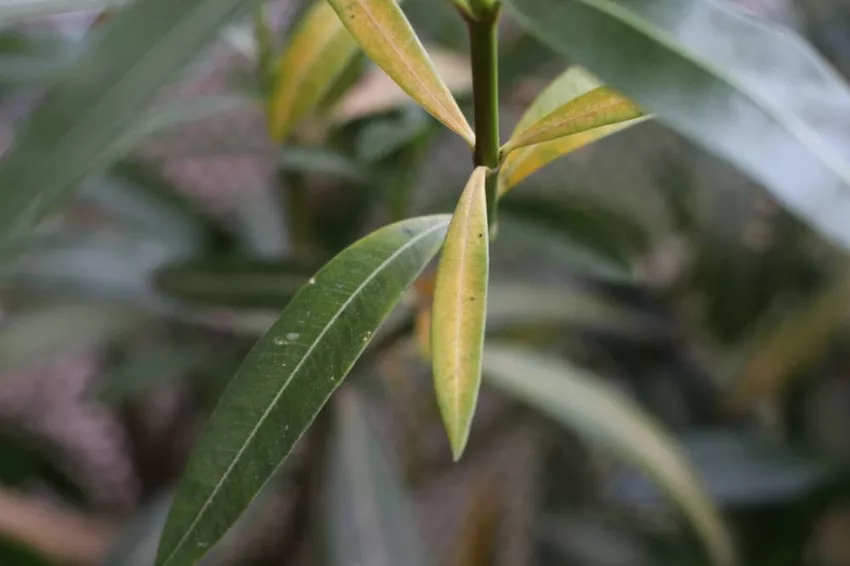- Oleander tolerates only light frosts
- Best possible protection in winter
- Overwinter potted plants frost-free
- Protect from frost outdoors
- What to do in the event of frost damage?
- frequently asked Questions

Oleander is one of the Mediterranean plants. He is used to mild winters with temperatures that rarely drop below zero. In Germany it is not hardy. But how sensitive to frost is the oleander?
In a nutshell
- Due to its origin, oleander (Nerium oleander) has only limited frost resistance
- very warmth-loving plants, which are mainly cultivated in tubs
- It tolerates light frost, temporary cold and snow without any problems
- it usually becomes critical from the middle or end of November
- then it is important to protect the oleander accordingly
Oleander tolerates only light frosts
There is no question that this ornamental tree is not hardy. Nevertheless, it tolerates light frost and temperatures down to minus five degrees as well as single night frosts without being damaged. Provided it is in a protected place. As a result, it can easily remain outdoors until late autumn.

- Do not permanently expose plants that need warmth to frost
- Temperatures below minus five degrees are not tolerated
- and prolonged frost with a cold east wind in the morning
- both result in serious damage
- up to the death of the oleander
- avoid direct winter sun on the leaves
- Frost damage to the root ball usually cannot be repaired
- Bale freezes through particularly quickly in the bucket
- Plant can no longer absorb water, it dies of thirst
Best possible protection in winter
At the end of the winter break, many plants are looking quite battered and need some time to recover. This is usually no different with the oleander. In these cases, a pruning can not only be useful, but unavoidable. However, this can have a negative effect on the formation of flowers, because this plant flowers mainly on biennial shoots. It is all the more important to ensure the best possible conditions during the winter.
Overwinter potted plants frost-free
Oleanders in tubs should overwinter in a roost protected from frost. Even if the frost tolerance is rather low, you should leave them outside as long as possible and put them outside again as early as possible in the spring. This hardens them and helps them survive the winter well.
An unheated winter garden or a cold greenhouse are particularly suitable as winter quarters. Since this plant keeps its leaves even in winter, it should be light with temperatures between two and ten degrees. If only a dark basement is available, you have to help with artificial lighting.

Tip: You should avoid pruning before wintering, because the pretty flowers develop from the freshly formed flowering shoots in spring. It is advisable to cut back after the first flowering in spring.
Protect from frost outdoors
In very mild and sheltered locations such as the Rhine Valley, this Mediterranean plant can also spend the winter outdoors. This applies to planted specimens as well as potted plants. However, only with sufficient protection.
- when planting in the bed, cover the root area with leaves and brushwood
- wrap above-ground parts of the plant with light- and air-permeable fleece
- Impermeability to air leads to mold and rot growth
- Place potted plants on a styrofoam board or wooden pallet
- Wrap the planter in bubble wrap or coconut mat
- put everything in a safe place
Tip: The winter location should be sheltered from both direct winter sun and cold winds, as well as rain. Ideally, you should place it in front of a warming house wall.
What to do in the event of frost damage?
However, if frost damage has occurred, this does not necessarily mean the end of your oleander. If the damage is not too serious, it can still be saved in most cases. As long as the roots have not suffered frost, it usually drives out again.

- Leaves usually damaged first
- only then do twigs, larger branches and finally the trunk follow
- clear warning signs are shoots that look brown and dried up
- cut off frozen leaves and branches as an immediate measure
- more severe pruning recommended for larger frost damage
- Cut complete plants about halfway down
You can test how severely the plant is ultimately damaged by nipping off some of the bark. If it is still green behind it, this part is not frozen. However, if it is woody-brown behind the bark, the affected twig or branch must be cut off.
frequently asked Questions
In which regions can oleanders overwinter outside?Overwintering outdoors is, if at all, only possible in mild winter regions with light frost. This is the case in the Rhineland, on the Lower Rhine, in the south-west and especially in wine-growing regions. Appropriate protection should not be dispensed with, however.
Do you cut off the inflorescences in autumn?The inflorescences should not be cut off if possible, provided there is no disease or pest infestation. If you cut them off, you also remove the flowering plants that are forming there for the next year. It would not flower the following year. They usually fall off on their own.
Does this plant need to be watered in winter too?Yes, both specimens in winter quarters and those outdoors. However, plants that stand outside in winter should only be watered on frost-free days and not too much. Waterlogging should be avoided in both variants.